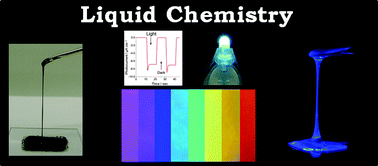The realisation of technologically high potential molecular materials as an innovative replacement for currently used materials requires sensible molecular design and subtle implementation. One such research concept “liquid chemistry” has recently been introduced as a third-generation of liquid materials after the first and second generations of solvent liquids and ionic liquids, respectively. The outstanding features of novel organic molecular liquid matter are solvent-free neat phase at room-temperature, nonvolatile, tunable optic and/or electronic functions, processability, etc. The availability of a paintable/printable liquid phase which can accommodate various dopants to generate functional composites is the main attraction of these molecular liquids. As promising candidates, emitting and semiconducting liquid materials have already been practically demonstrated and which may replace inorganic or self-assembled organic semiconductors in performance and processability. Compared to ionic liquid materials obtained by lowering the glass transition temperature through ionic interactions, covalently functionalised organic liquid matter is conceptually unique and exhibits several advantages. In this feature article, the recent developments in the emerging research field of functional molecular liquid materials are discussed.

You have access to this article
 Please wait while we load your content...
Something went wrong. Try again?
Please wait while we load your content...
Something went wrong. Try again?


 Please wait while we load your content...
Please wait while we load your content...